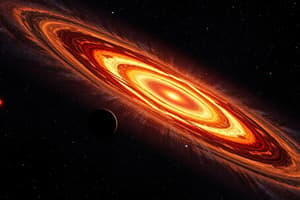Podcast
Questions and Answers
What does Nebular Theory state?
What does Nebular Theory state?
- Planets formed from a spinning disk of matter (correct)
- Venus and Uranus rotate on their axes in the same direction
- The Sun formed from a black hole
- All planets orbit in random directions
What triggers the gravitational collapse in Solar System Formation?
What triggers the gravitational collapse in Solar System Formation?
A shockwave from a nearby Supernova
All planets in the solar system rotate on their axes in the same direction.
All planets in the solar system rotate on their axes in the same direction.
False (B)
What is a protostar?
What is a protostar?
The process of particles growing via static electricity during the Solar System formation is known as ______.
The process of particles growing via static electricity during the Solar System formation is known as ______.
What happens during the heavy bombardment stage?
What happens during the heavy bombardment stage?
What are icy planetesimals believed to have brought to Earth?
What are icy planetesimals believed to have brought to Earth?
What defines asteroids?
What defines asteroids?
What characterizes a comet?
What characterizes a comet?
The Frost Line marks temperatures at which ______ can condense.
The Frost Line marks temperatures at which ______ can condense.
Flashcards are hidden until you start studying
Study Notes
Nebular Theory
- Explains the formation of the solar system from a spinning accretion disk.
- Most planets orbit in the same plane known as the "ecliptic."
- All planets revolve in the same direction around the Sun.
- Inner planets are rocky and small, while outer planets are large and gaseous.
- Venus and Uranus rotate backward on their axes, while Pluto has an inclined orbit.
- Contains strange debris including asteroid belts, Kuiper Belt, and Oort Cloud.
Solar System Formation
- Initiates with a dark molecular gas cloud experiencing a shockwave from a nearby supernova, leading to gravitational collapse.
- In-falling gas and dust convert gravitational potential energy into kinetic energy, raising temperature as the cloud forms a sphere and starts rotating.
- The flattened disk allows gas particles to condense into solid particles, marking the start of planet formation.
- Accretion occurs through soft collisions, leading to growth via static electricity.
- Boulder-sized objects form through gravitational attraction.
- Heavy bombardment stage ensues where planetesimals collide, affecting all celestial bodies in the solar system.
- Temperature within the gas region rises to 10 million K, igniting hydrogen fusion and birthing a star.
- Solar wind clears excess debris, halting planet formation.
Protostar
- Refers to stars that have not yet begun the fusion process.
Condensation Sequence
- Solar nebula composition: 98% hydrogen and helium, 2% heavier elements.
- Condensation processes involve matter transitioning to a denser phase.
Accretion
- Describes the process where smaller particles collide and stick together, forming larger bodies.
Heavy Bombardment
- A period where every body in the solar system faced impact from planetesimals, influencing surface geology.
Planetesimal
- Icy planetesimals formed in the outer solar system are credited with delivering water to Earth.
Asteroids
- Small, rocky celestial bodies that primarily orbit the Sun in the asteroid belt between Mars and Jupiter.
Comets
- Comets feature a glowing head and an extended tail of gas and dust, with the tail always directed away from the Sun due to solar wind heating the icy nucleus.
Frost Line
- The Frost Line marks the temperature gradients in the solar system:
- At Mercury's orbit, temperatures allowed for metals and rocks to condense.
- In the asteroid belt, temperatures were sufficient for carbon-rich minerals to form.
- Beyond the asteroid belt, temperatures dropped enough for hydrogen compounds to condense.
Studying That Suits You
Use AI to generate personalized quizzes and flashcards to suit your learning preferences.




